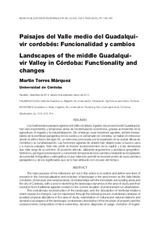Paisajes del Valle medio del Guadalquivir cordobés: Funcionalidad y cambios
Landscapes of the middle Guadalquivir Valley in Córdoba: Functionality and changes
Autor
Torres-Márquez, Martín
Editor
Universidades Públicas de AndalucíaFecha
2013Materia
Valle del GuadalquivirRegadío
Rururbanización
Agricultura periurbana
Córdoba (España)
Irrigation
Rur-urbanization
Peri-urban agriculture
METS:
Mostrar el registro METSPREMIS:
Mostrar el registro PREMISMetadatos
Mostrar el registro completo del ítemResumen
Los tradicionales paisajes agrarios del Valle cordobés, ligados a la presencia del Guadalquivir,
han sido importantes y tempranas áreas de modernización económica, gracias al desarrollo de la
agricultura, el regadío y la industrialización. Sin embargo, esas funciones agrarias, antaño insepa-
rables de la identidad paisajística de los ruedos y el extrarradio de Córdoba, se hallan en retroceso
desde el último tercio del siglo XX, un retroceso provocado por la expansión de la ciudad difusa de
Córdoba y su rururbanización. Las funciones agrarias de antaño han dejado paso a nuevos usos
y a nuevos paisajes, todo ello unido al devenir socioeconómico de la capital y a las demandas
que ésta exige de su entorno. El presente artículo, utilizando argumentos y principios geográfi co-
históricos, persigue la descripción y concreción temporal de esos cambios mediante la recopilación
documental, fotográfi ca y cartográfi ca, lo que habrá de permitir la reconstrucción de esos cambios
paisajísticos y de los signifi cados que se le han atribuido con el paso del tiempo The main purpose of the refl ections set out in this article is to outline and defi ne new lines of
research in the conceptualisation and evolution of landscape in the area known as the Valle Medio
Cordobés, its terraces and meadow lands, its relationships with the immediate surrounding areas and
the city of Córdoba, with a view to sketching the landscape dynamics in the area of study and their
evolution from traditional agrarian models to the current situation of predominant rur-urbanisation.
This evolutionary reconstruction of the landscape, and the description of territorial relations
which explain its changes, can be expressed through the following issues: evolutionary analysis of
possible physical alterations in the area of study; examination of cultural and natural relations and
dynamics as shapers of the landscape; evolutionary description of the structure of property and the
socioeconomic composition of land ownership; dynamic diagnosis of usage; evolution of organised or infrastructural landscape; communication, service and supply links, etc.; and chronological
reconstruction of the landscape identity of the area studied.
The methodological proposal used, within fl exible parameters, is as follows: search and analysis
of historic and recent bibliography; archive search (Municipal Archive of Córdoba, Historic Provincial
Archive of Córdoba, Archive of the Hydrographical Confederation of the Guadalquivir, Archive of
the Guadalmellato Irrigation Association, Municipal Urban Planning Department, Cadastral Register,
General Archive of Simancas, National Historic Archive and Royal Chancery of Granada); search
and study of historic and contemporary cartographic sources; and fi eldwork.
The fi ndings of this research have revealed, fi rstly, the undisputable strategic value of
the Valle Cordobés within the geographic and urban context of the city of Córdoba, since this
nucleus, its history and socioeconomic needs have since time immemorial conditioned the uses
made of its rural surroundings. Similarly, evolutionary analysis of the territory and the agrarian
landscape of its outlying areas shows the existence of an evident dynamic of transformation,
destruction and reconstruction, associated with the needs of Córdoba and its inhabitants.
From natural corridor and communication link, to the current rur-urban scenario, the Valle
Medio Cordobés area has moved through the predominance of extensive agrarian uses, the
exploitation of the ‘dehesa’ pasture lands for livestock, and the introduction of irrigation and
agro-industrialisation. And in this development, an intensely humanised environment has been
shaped, littered with anthropic imprints and also symbols and identities which have changed
along with the predominant uses and demands imposed by the city of Córdoba itself.
From the mid 1950s up to the present day, there has been a process of de-agrarianisation in
the Valle Cordobés area, accompanied by a division of property which has practically eradicated the
former predominance of large ‘Latifundio’ estates. There has also been a sustained diminishment,
particularly since the 1980s, of the irrigable land area of Guadalmellato, which was once particularly
highly valued. In addition to the peri-urban growth of Córdoba and Almodóvar, the creation of certain
industrial estates, and the increase in residential areas of certain population nucleuses such as Vil-
larrubia, this area has also been witness to a process of rur-urban parcelling. The once extensive
swathes of agricultural land have been divided up into small plots of just 1,000 and 1,500 m
2
, which
are now home to chalets, swimming pools, allotments, small industries, and restaurants, etc

